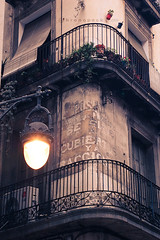 Image by Breno Peck via Flickr
Image by Breno Peck via FlickrBy Harry Preston 
The Gothic Quarter is Barcelona's historic heart. Despite its name, it's not all Gothic, and many of the Gothic-looking features in its narrow streets and historic buildings actually date from the 19th and 20th centuries. The area's origins, however, are even older - this is where the original Roman settlement of Barcino was built.
The Roman centre of town is still the heart of the Barri Gotic - the Placa de Sant Jaume, which today is home to the Catalan and Barcelonan local govemment buildings. Remains of magnificent Roman columns from the Temple of Augustus can be seen in the interior patio of Carrer del Paradis 10, behind the Gothic cathedral, one of the area's true Gothic constructions (at least in part), with beautiful, peaceful cloisters. Peaceful, that is, when the resident half dozen geese aren't creating a ruckus for food! The route of the old city walls, remains of which can still be seen (for example at the bottom of Carrer Baixada Viladecols), roughly traces the outer border of the Barri Gotic and covers Via Laeitana, Passeig de Colom, La Rambla and Carrer de Fontanella. The part of the Barri Gotic nearest to the sea has a somewhat rougher air than the more open, modernised, shopping-orientated zone above carrers de Ferran and de la Jaume I. Two of Barcelona's most popular refreshment areas, Placa Reial and Carrer de la Merce are here. Both visitors and locals come here to sip wine or cider from the barrel and taste traditional tapas. The Gothic Quarter probably has Barcelona's highest concentration of bars and restaurants, so if you're not sure where to go for dinner, just wandering the streets should offer you plenty of options. But the Barri Gotic has more highbrow attractions. In addition to the cathedral, it features many other important examples of religious architecture, from Santa Maria del Pi to the Esqlesia de la
Merce and the matchbox-sized Capilla de Sant Cristobal on Carrer del Regomir. The Museu Frederic Mares, behind the cathedral offers a fascinating insight into the everyday objects used in 19th-century society, from cameras to combs. The Col. legi d'Arquitectes de Catalunya on Placa Nova often holds architectural exhibitions and the Museu d'l-llstoria de la Ciutat is a living historic architectural exhibit in itself, comprising some of Barcelona's major medieval buildings, as well as housing some of the city's most important Roman ruins. A more unusual museum can be found in the lovely Placa de Sant Felip Neri - the Museu del Calcat (shoe musuem) - where you can see the footwear of famous Catalans.

The Gothic Quarter is Barcelona's historic heart. Despite its name, it's not all Gothic, and many of the Gothic-looking features in its narrow streets and historic buildings actually date from the 19th and 20th centuries. The area's origins, however, are even older - this is where the original Roman settlement of Barcino was built.
The Roman centre of town is still the heart of the Barri Gotic - the Placa de Sant Jaume, which today is home to the Catalan and Barcelonan local govemment buildings. Remains of magnificent Roman columns from the Temple of Augustus can be seen in the interior patio of Carrer del Paradis 10, behind the Gothic cathedral, one of the area's true Gothic constructions (at least in part), with beautiful, peaceful cloisters. Peaceful, that is, when the resident half dozen geese aren't creating a ruckus for food! The route of the old city walls, remains of which can still be seen (for example at the bottom of Carrer Baixada Viladecols), roughly traces the outer border of the Barri Gotic and covers Via Laeitana, Passeig de Colom, La Rambla and Carrer de Fontanella. The part of the Barri Gotic nearest to the sea has a somewhat rougher air than the more open, modernised, shopping-orientated zone above carrers de Ferran and de la Jaume I. Two of Barcelona's most popular refreshment areas, Placa Reial and Carrer de la Merce are here. Both visitors and locals come here to sip wine or cider from the barrel and taste traditional tapas. The Gothic Quarter probably has Barcelona's highest concentration of bars and restaurants, so if you're not sure where to go for dinner, just wandering the streets should offer you plenty of options. But the Barri Gotic has more highbrow attractions. In addition to the cathedral, it features many other important examples of religious architecture, from Santa Maria del Pi to the Esqlesia de la
Merce and the matchbox-sized Capilla de Sant Cristobal on Carrer del Regomir. The Museu Frederic Mares, behind the cathedral offers a fascinating insight into the everyday objects used in 19th-century society, from cameras to combs. The Col. legi d'Arquitectes de Catalunya on Placa Nova often holds architectural exhibitions and the Museu d'l-llstoria de la Ciutat is a living historic architectural exhibit in itself, comprising some of Barcelona's major medieval buildings, as well as housing some of the city's most important Roman ruins. A more unusual museum can be found in the lovely Placa de Sant Felip Neri - the Museu del Calcat (shoe musuem) - where you can see the footwear of famous Catalans.
For more information about Barri Gotic or Barcelona, Spain visit GuidedTourBarcelona.com.
For more information about Boston or the Boston Celtics visit GuidedTourBoston.com.
For more information about Boston or the Boston Celtics visit GuidedTourBoston.com.
Article Source: http://EzineArticles.com/?expert=Harry_Preston
Search Amazon.com for vino con vista